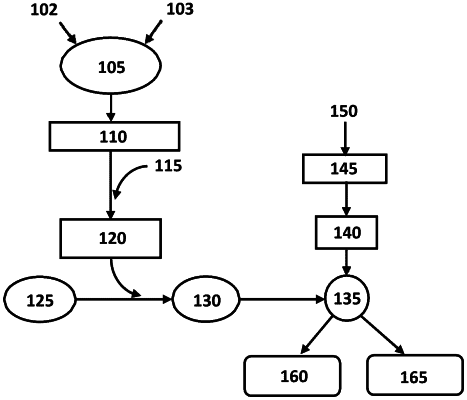| CPC G16B 40/00 (2019.02) [C10G 75/00 (2013.01); G01N 21/3577 (2013.01); G01N 21/359 (2013.01); G01N 24/081 (2013.01); G01N 24/085 (2013.01); G01N 33/2823 (2013.01); C10G 2300/4075 (2013.01)] | 19 Claims |

|
1. A process for producing a liquid transportation fuel in a petroleum refinery, comprising:
a) analyzing a sample of a first hydrocarbon stream selected from a member of the group consisting of crude petroleum, a crude petroleum fraction, a refinery intermediate stream and a refinery hydrocarbon product by an analytical method selected from mid-infrared spectrometry, near infrared spectrometry, Ramen spectroscopy and nuclear magnetic resonance spectroscopy to produce spectral data comprising a set of discrete digitized data points;
b) transforming a subset of the spectral data to produce sample wavelet coefficients data according to wavelet theory by applying a mother wavelet that is a selected from a group consisting of Symlet, Haar and the Coiflets families of mother wavelets, wherein each discrete digitized data point within the subset of the spectral data is converted to a wavelet coefficients data point;
c) training a genetic algorithm to classify the sample wavelet coefficients data into one of two groups consisting of a first group and a second group to produce a trained genetic algorithm,
wherein the first group comprises multiple training hydrocarbon streams of distinct origin, wherein each training hydrocarbon stream is selected from the same member of the group as the first hydrocarbon stream of a), wherein each member of the training hydrocarbon stream has at least one attribute in common that is distinct from the second group,
wherein the training comprises performing the analyzing of part a) on each of the multiple training hydrocarbon streams from both the first group and the second group to produce training wavelets coefficients data and presenting the training wavelets coefficients data obtained from each training hydrocarbon stream to an untrained genetic algorithm that recognizes subtle collective differences within the training wavelet coefficients data obtained from each member of the first group compared to the training wavelet coefficients data obtained from each member of the second group to produce a trained genetic algorithm that successfully associates the collective differences with the presence of the at least one attribute at or above a predetermined threshold level, wherein the training further comprises an iterative process wherein each iteration places increasing emphasis on wavelet coefficient data points that increase the probability of accurately classifying the sample into either the first group or the second group;
d) classifying the sample of a) as a member of either the first group or the second group by presenting the sample wavelets coefficients data of b) to the trained genetic algorithm, wherein the trained genetic algorithm performs the classifying by examining one or more identifying spectral features that collectively identify the sample as a member of the first group or the second group;
e) performing an action selected from:
converting the first hydrocarbon feed stream to one or more liquid transportation fuels in a commercial petroleum refinery when the sample of a) is classified as a member of the first group,
diluting the first hydrocarbon feed stream with a second hydrocarbon feed stream when the sample of a) is classified as a member of the second group, wherein the second hydrocarbon feed stream is mixed with the first hydrocarbon feed stream in an amount sufficient to produce a diluted hydrocarbon feed stream comprising less than a threshold quantity of the at least one attribute, then converting the diluted hydrocarbon feed stream to one or more liquid transportation fuels in a commercial petroleum refinery, or
not converting the first hydrocarbon feed stream in a commercial petroleum refinery when the sample of a) is classified as a member of the second group.
|